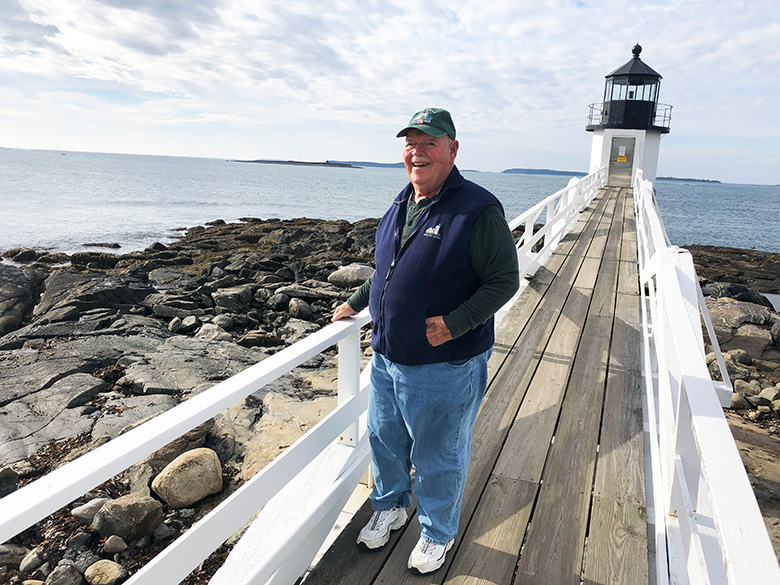One of the Maine coast’s most recognizable, beloved—and accessible—scenes might have had another fate. In 1988, a rumor circulated through St. George—which includes the villages of Port Clyde, Tenants Harbor, and Martinsville—that the Marshall Point Lighthouse would be converted into a hotel and resort property.
This is the iconic site that appeared in the 1994 film Forrest Gump, in which Tom Hanks as Gump ran down the walkway to the light tower (in fact, visitors often mimick Gump’s run up and down the walkway). It’s the place where untold numbers of engagement and wedding photos are shot. Where school children study the contents of tidal pools. Where tourists feel the bracing breeze off Penobscot Bay and locals point out for them the cliffs of Monhegan Island on the horizon.
All those years ago, locals and summer folk alike mobilized to save the Marshall Point Lighthouse from going into private hands, and that’s worth noting.
“The Coast Guard thought we’d lose interest. Well, that never happened. Three years later, we opened the museum.”
But it’s also worth noting, says Nat Lyon, chairman of the Marshall Point Lighthouse Committee, that as of June, the walkway has been stabilized after being damaged from the January 2024 storms.
“The water came right up to the base of the porch steps,” he says, and the road was strewn with rocks. The $150,000 project was completed with funds raised by the committee, not the town.
And if anniversaries are important, well, the museum now housed in the first floor of the keeper’s house opened 35 years ago.
Lyon moved to the area in 1999 from Massachusetts and so wasn’t around when the hotel plan was thwarted. But he’s familiar with the story, and his recounting of the town’s response is blunt: “They said ‘No way!’”
Other key dates in the lighthouse’s history include it being established on the site in 1832, though the current light was built in 1858. The keeper’s house burned in 1895 and was rebuilt.

In 1971, the last lightkeeper left the post, and when Loran signal technology was installed, the Coast Guard abandoned the property in 1981 and boarded up the windows on the keeper’s house. A summer kitchen, which had been added to the land side of the building, was torn down when the operation was automated, as were a barn and a lifeboat station near the shore.
Back in 1988 when the hotel rumors were circulating, locals, including Irene Rizkalla, organized the committee and launched a campaign to rehabilitate the keeper’s house and open a museum there.
“I was heart-broken,” Rizkalla remembers feeling when she heard the rumor, which included the possibility of tearing down the keeper’s house. “It made me totally heartsick. The people from Port Clyde,” which is where Marshall Point is located, “were very upset. And when I heard, I got very upset!”
She lives in a circa-1790 house in St. George village and in conversation, it’s clear her roots and love for this community run deep. She points to seats at her dining room table where people gathered to plan their effort to block the hotel.
“We made a plan, got the key, and started cleaning the building,” she remembers. “The Coast Guard thought we’d lose interest. Well, that never happened. Three years later, we opened the museum.”
In fact, the Coast Guard entered into a 30-year lease, initially with the St. George Historical Society.
The committee has succeeded raising enough money to sustain maintenance of the lighthouse.
“We’ve put more than $500,000 back into the property,” Lyon says. Some of the revenue comes from renovating and then renting a second-floor apartment in the keeper’s house.
“It has to be someone who can live in four small rooms,” Lyon said. “Great views, but small space.”
The museum, with free admission, has been a success, he says, with about 23,000 visiting during the warm months. In 1995 the committee added back the summer kitchen structure which houses the collections.
There are displays of old lobster buoys and sardine cans, tools from the granite industry, vintage photos of the site, explanations of Loran, light lenses, and historical documents and genealogies, along with a gift shop. This year, 64 volunteers were on-hand to keep the museum open for visitors.
Though Lyon moved to the area 26 years ago, he has been active in the community, working as a sternman for 11 years and on the Monhegan Boat Line for five. And he’s proud to be part of the effort to sustain the property.
“That’s the whole thing, to preserve this as long as we can,” he says.
Rizkalla, too, expresses pride in “the fact that we have done it, and now own it. No one can take it away from us.”





